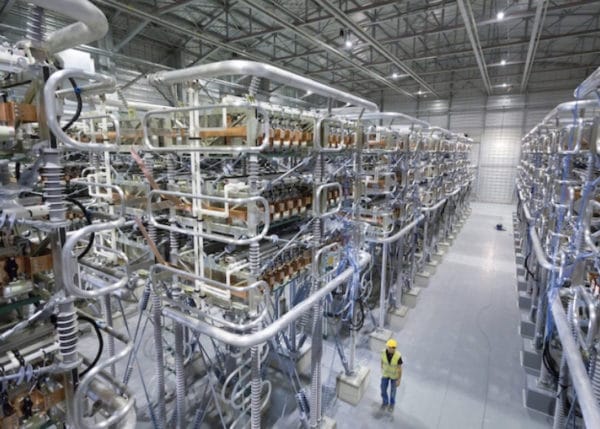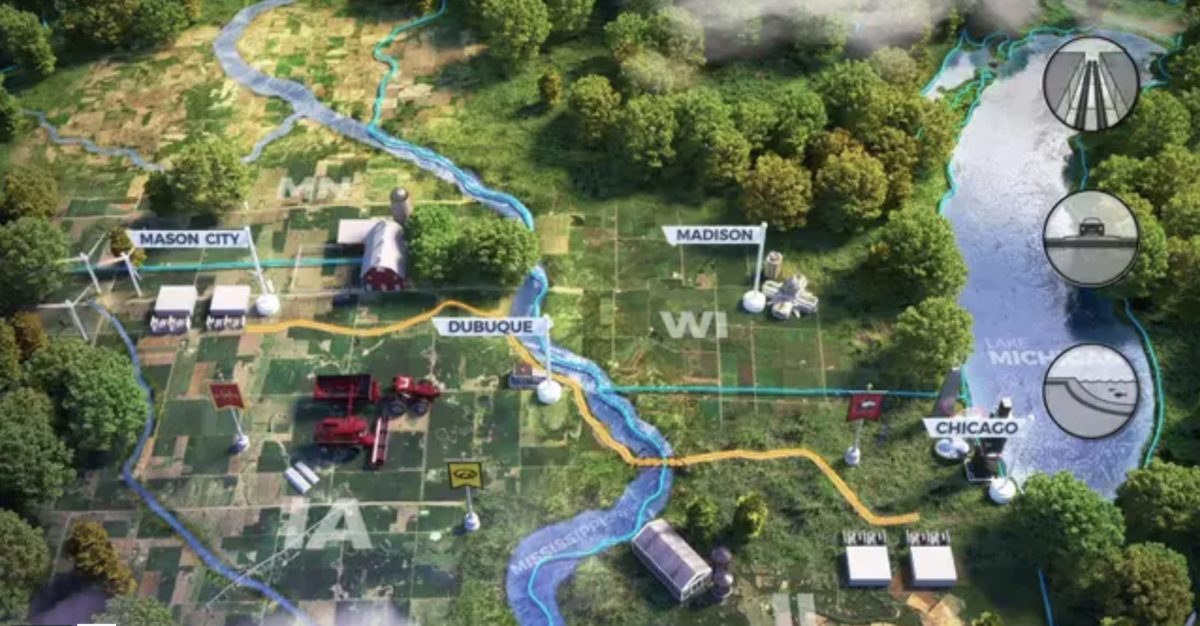A high-voltage direct current (HVDC) transmission project that would bring wind power from Iowa eastward, largely along railroad rights-of-way and entirely underground, has gained funding commitments from Copenhagen Infrastructure Partners, Jingoli Power, and Siemens Financial Services. Their investments validate the prospects for the 349-mile, 2.1 GW transmission line, which is being developed by the Direct Connect Development Company, and would cost $2.5 billion.
Underground transmission has appeal because it is out of sight and out of mind, while co-location with a rail line means that a single agreement with a railroad company can yield hundreds of miles of the path needed for a transmission line.
The project’s website says that “some of the best wind resources in the world” are found in the Upper Midwest, and adds that the HVDC line will also transmit solar power.
But when it comes to HVDC transmission primarily delivering solar power, the only publicly available U.S. study showed that HVDC could economically transmit solar power from sunnier regions to less sunny regions, but that adding HVDC transmission would not result in more solar overall. Rather, it could lead to more solar development in sunnier regions but less solar development in other regions, leaving the total approximately unchanged.
Preliminary results of that “Interconnections Seam Study,” led by Aaron Bloom, a former manager at the National Renewable Energy Laboratory (NREL), are available in a slide deck, in which slide 84 shows that the cost-optimal amount of solar installed by 2038 would change little if long-distance HVDC transmission were added across the U.S. “As you build transmission,” Bloom explained in an email, solar capacity would be relatively more profitable in the West and less profitable in the East. System-wide cost savings would result from many shifts in capacity additions and generator operations. A video presentation on the study is also available.
And although the Los Angeles municipal utility is participating in an NREL study on how it may best achieve 100% renewables, with added transmission as one of the options, that study will not yield final results until December.
The Direct Connect Development Company’s Midwestern project has posted a video showing how it will use two HVDC cables side by side, each inside its own conduit, typically laid in a five-foot-deep trench and covered with the original soil. To place HVDC cable under roads or waterways, a bore will be drilled, and a casing inserted to contain the conduits with their cables. The project has strategic partnerships with Canadian Pacific Railway, for use of the railroad right-of-way, and with Siemens, which will provide HVDC converter technology. Project developers must still obtain some required permits.
 The project’s website describes its plan to use “innovative converter stations known as self-commutated Voltage Sourced Converters (VSC)” that will “boost reliability by providing highly responsive utility-scale reactive power, dynamic voltage support, black start and other grid services.” The project will include two VSC power converter stations, one at each end of the HVDC line. The VSC stations, says the project website, “will convert AC power produced by wind and solar generators in MISO to DC to enable transmission over the line, and then back to AC power for distribution to customers in PJM.” MISO and PJM are regional electric grids.
The project’s website describes its plan to use “innovative converter stations known as self-commutated Voltage Sourced Converters (VSC)” that will “boost reliability by providing highly responsive utility-scale reactive power, dynamic voltage support, black start and other grid services.” The project will include two VSC power converter stations, one at each end of the HVDC line. The VSC stations, says the project website, “will convert AC power produced by wind and solar generators in MISO to DC to enable transmission over the line, and then back to AC power for distribution to customers in PJM.” MISO and PJM are regional electric grids.
The investor Copenhagen Infrastructure Partners has also backed a pumped hydro storage project in Montana.
This content is protected by copyright and may not be reused. If you want to cooperate with us and would like to reuse some of our content, please contact: editors@pv-magazine.com.








At this particular project it is $7.2 million dollars per mile of HVDC line. I’d imagine in population dense cities like NYC it would be $10 to perhaps $20 million per mile of power corridor.
Apparently no one looked into solar PV or wind generation in these two areas, using energy storage to create the micro-grid for the particular area without any additional power corridor connections.
I’d be surprised it makes great financial sense given that PV costs are still significantly falling. But, good for overall Grid Support and when whether is in the East.
I can see your point of the population dense Eastern U.S. as compared to the less populated South and West U.S.. Can you explain how a HVDC (buss) of 349 miles using basically a trench for most of the trip would be maintained? I can see in the HVAC transmission lines, one can tap off of the HVAC transmission line and put in a switching station to service a new customer base. One would (not) do this with a HVDC feed? Say one installs a “Middle” America HVDC connection that is 1,000 miles from say wind farms in Kansas into the Eastern market. As one perhaps extends this HVDC line West to pick up more alternatively generated energy how does the basic tapping in of “other” generation facilities match the voltage of this HVDC buss. Would not there be a tendency for say a generation facility in Colorado or Utah to have HVDC flow (into the facility) if and when the sun goes behind clouds or the wind starts to die down? Now as you tap into the HVDC buss and tap into more alternative energy generation resources, resources that might be from a few MW to several hundred MW of generation potential how does one regulate the buss and keep current flowing in one direction to feed the buss? When this HVDC buss is used to power a local town with its own micro-grid, how does one regulate what’s going on down the line where intermittent generation is being fed into a grid that feeds the HVDC buss. Are we talking about very large scale energy storage spaced some advantageous distance all along the run of the HVDC buss with no real direct connections to a load down the line?
The underground cable lines do not need any maintenance. In case of cable failure the failed portion of the cable can be replaced.. Access to the cable can be done either through the railway or through neighboring properties.
Regarding voltage regulation, HVDC lines are like long extension highways -they are designed for point to point interconnection, with no middle point tap ins i.e. if there’s a need to feed loads along the way you’ll probably be better of with AC connections. Voltage regulations with modern HVDC technology is done both with HVDC Converter transformers tap changers (considering converter needs) and with the supply of Reactive Power (considering local AC grids)